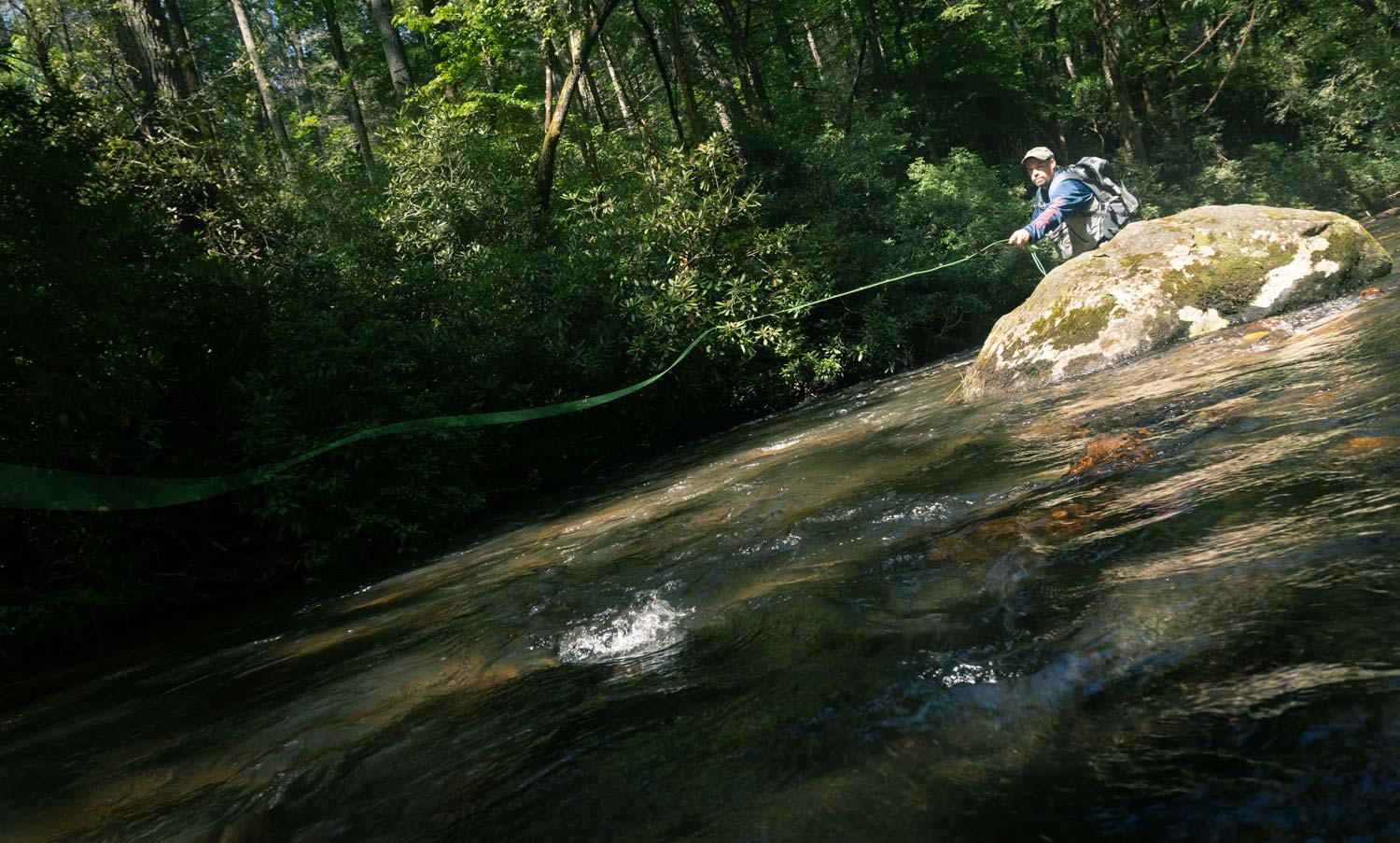
Photos by Louis Cahill
By Jason Tucker
Alex waded into the pool, pushing a bow wave ahead of him that lapped against the grass on the far bank– not that far, as he could almost reach it with the tip of his rod.
What is he doing? I thought. He’s going to put down every fish in the bend and pool. I would have pushed through the tag alders over the shallow sand so as to stay out of the pool. Yet there Alex stands, waist deep in water, almost on top of where he needs to cast. A few feet downstream, near where he had just walked, a good fish rose, and I fought the urge to flip my fly out there, leaving the first cast to Alex.
Alex made a single cast, and his fly disappeared with a loud slap. He set the hook and chaos ensued as his line rooster tailed through the water. The fish turned and swam back up to Alex, then ran back downstream, streaking past my leg on the surface- the biggest brook trout I’ve ever seen outside of Canada. It was easily four pounds and probably five. Big and thick and over twenty inches long. Then it turned and dogged its way upstream, and the leader parted for no apparent reason. It wasn’t even under that much pressure at the moment. We all stared in disbelief at the dangling end of his line.
I don’t know why Alex’ approach that night resulted in hooking up on his best brook trout ever (if you count fish not landed). My best guess is that it was late evening and the fish, anticipating the evening hatch, had moved out to feed, and the dropping light gave them confidence. Normally I would have thought he had buggered the entire hole, but that night his approach resulted in a hookup and one of the most bittersweet memories in our time fishing together. Alex still can’t talk about it.
Alex is a cautious fisherman. He wears camo when he fishes for brook trout and is generally very cautious. I don’t wear camo, but it’s not a bad idea. Small streams, being small require an extra level of stealth. Here are some things you can do to increase your success on small streams.
Elements of stealth
Clothing- camo, dull colors, sky blue
Stealth on any stream starts at home with your clothing. Leave the bright colors at home. The dull colors most waders come in is a good place to start. Don’t hesitate to wear your hunting camo. Dull shades of green, brown and grey will work best. I personally don’t care for black- I think it offers too much contrast. Because the fish are looking up I think sky or pale blue is not a bad choice, especially as part of a camo pattern. On a small stream you are fishing in tight quarters, sometimes almost on top of the fish, and you want to blend with the background as much as possible.
Observation- slow down!
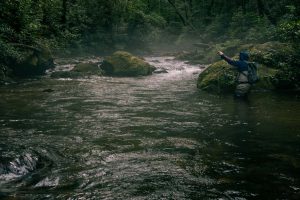 I can’t tell you the number of times I still plow into a stream only to realize I have bumped a good fish. I personally do not like fishing close to the access, and at times don’t even care that I’m bumping fish on my way to where I really want to fish. But when I get to there, it really hurts to step into the stream only to realize I’ve blown up the spot by not being more observant. I’m looking both for fish and also what they may be feeding on. Often we know to some degree what’s going on- you’re fishing a specific hatch, or it’s midsummer and you’re fishing terrestrials. Maybe the weather is cool and you are planning to fish a nymph rig. But conditions change every day and it never hurts to take a few minutes and observe what’s going on. Angling activity by its very nature puts fish down. Once you start casting there’s no going back- you have created disturbance, and everything is working against you. If you have taken the time to make sure you have on the right fly, and are placing it where the fish are, you are maximizing your odds of hooking up.
I can’t tell you the number of times I still plow into a stream only to realize I have bumped a good fish. I personally do not like fishing close to the access, and at times don’t even care that I’m bumping fish on my way to where I really want to fish. But when I get to there, it really hurts to step into the stream only to realize I’ve blown up the spot by not being more observant. I’m looking both for fish and also what they may be feeding on. Often we know to some degree what’s going on- you’re fishing a specific hatch, or it’s midsummer and you’re fishing terrestrials. Maybe the weather is cool and you are planning to fish a nymph rig. But conditions change every day and it never hurts to take a few minutes and observe what’s going on. Angling activity by its very nature puts fish down. Once you start casting there’s no going back- you have created disturbance, and everything is working against you. If you have taken the time to make sure you have on the right fly, and are placing it where the fish are, you are maximizing your odds of hooking up.
Presentation- don’t cast over fish, land your casts quietly, make quiet mends
Now you’ve stalked into position within casting distance of a rising trout. You need to follow through with a stealthy presentation. If you can make a single cast to the fish, you should. Keep false casting to a minimum. If you must false cast, do it over land or empty water, not over the head of the fish. Their vision is tuned to movement. Land that cast as gently as possible, even if it’s a nymph rig. Mend quietly, or try to mend in the air before the cast lands. That’s ninja level casting, but it’s possible. I practice it on every run after I’ve fished it out and put the fish down. It usually takes me half the day to start making it happen in actual fishing situations. You are trying to achieve three things- 1. Get the fish to eat on the first presentation, 2. Give yourself additional opportunities if it doesn’t eat on the first cast and 3. Allow opportunities at other fish in the immediate vicinity if that first fish doesn’t eat.
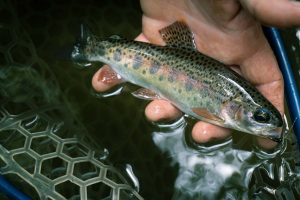 Fighting and landing fish– This is an area you have less control of, but if you can fight and land a fish quietly it increases your odds of going for a second in the same spot, especially if you saw a larger fish feeding but hooked up on a small fish. Try to steer the fish immediately downstream or into shallow water and away from where the fish are holding. There’s not much you can do if the fish is jumping or is too big to control (in which case mission accomplished), but sometimes it buys you a second chance at more fish.
Fighting and landing fish– This is an area you have less control of, but if you can fight and land a fish quietly it increases your odds of going for a second in the same spot, especially if you saw a larger fish feeding but hooked up on a small fish. Try to steer the fish immediately downstream or into shallow water and away from where the fish are holding. There’s not much you can do if the fish is jumping or is too big to control (in which case mission accomplished), but sometimes it buys you a second chance at more fish.
Get away from the access; be observant
I have a basic premise for all my fishing that the area near any access gets too much pressure and that I’m better off moving upstream or down and away from the immediate access. Once I get to where the trail grows more faint and evidence of fishing pressure subsides, then I start to pay more attention and slow down. No matter how stealthy you are, if the last five anglers before you stirred things up there’s probably not much you can do to get the fish to feed.
If you’re there to fish a specific hatch, then your approach will be to go to your spot, then wait for the hatch to happen. But if you’re going to the stream to fish regardless of conditions, you’re going to need to do some observation.
Spend some time at it. Give yourself ten or twenty minutes to decide what and how to fish. The tendency here in the Southeast is to tie on a two-nymph rig under a bobber at the car and head to the stream. But some days I get to the stream and find that some fish are rising. I don’t know about you, but I would rather fish to rising fish any day over nymphing. Some days it’s good to walk to the river without rigging up and check out what’s happening first. Heck, give yourself some time to relax and enjoy the river- the sounds, the running water, the birds, and the breeze in the tree tops. Take a few minutes to get yourself out of warrior mode. Get in tune with the river. The first step in stealth is just slowing down. Become an observer.
Once you’ve gotten in tune with the river, decide what and how you’re going to fish. Fishing dry flies will entail more stealth than nymphing or streamer fishing, but the less aware the fish are of your presence, the more likely they are to eat your fly.
Movements. Trout are completely tuned in to their environment. They see you when you step to the stream bank. They hear your boots on the gravel. They see the brush shaking unnaturally as you crash through it. They are looking up at the same unchanging scene on the surface every day, all day, until your ripples and bow waves pass overhead.
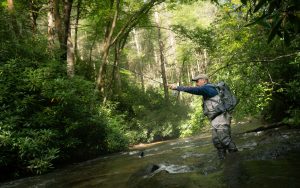 Keep your movements slow and deliberate. Be quiet. Ease yourself into position. If you are approaching a rising fish wait before casting to see that it continues feeding. If it has stopped feeding it probably detected your presence so try to wait a few minutes and see if it resumes feeding. If you are at a place you know holds fish, It can be worth waiting a long time for the fish to resume normal feeding.
Keep your movements slow and deliberate. Be quiet. Ease yourself into position. If you are approaching a rising fish wait before casting to see that it continues feeding. If it has stopped feeding it probably detected your presence so try to wait a few minutes and see if it resumes feeding. If you are at a place you know holds fish, It can be worth waiting a long time for the fish to resume normal feeding.
Trout face upstream so approaching from downstream can help, but they are also especially sensitive to being approached from behind. They will actually tolerate some disturbance from upstream as long as you are far enough away that they think they have time to escape. Either way you want to keep your movements slow and calm, waiting to cast until you are in position.
When you’re ready, make that first cast count. Every time your fly and line hit the water the fish become increasingly aware that something is going on. Pick your most likely spot and do your best to make a good cast with little or no false casting. One mistake I’ve observed beginning anglers make is water loading their rod to cast. I think some casting instructors teach it as an easy way to get the rod loaded. They flip out a short cast onto the water, use the extra tension to load the rod and then cast. This is a terrible idea on a small stream, but I’ve seen some people start every cast this way. It’s a cheap trick that makes you a worse angler. Don’t do it.
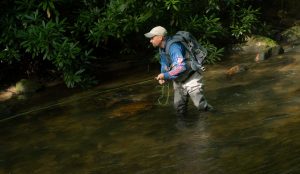 In general I walk upright while on the stream, but there are places where you will either want to crouch, or even get down and crawl into position. It can be helpful to use either tall grass or brush to hide your approach, but avoid making the brush shake. There’s places where you’ll want to ease through the grass, and when you reach the edge, drop to your knees slowly and make that first cast count.
In general I walk upright while on the stream, but there are places where you will either want to crouch, or even get down and crawl into position. It can be helpful to use either tall grass or brush to hide your approach, but avoid making the brush shake. There’s places where you’ll want to ease through the grass, and when you reach the edge, drop to your knees slowly and make that first cast count.
Substrate also affects stealth. Sand is quieter to walk on then crunching gravel. I have been betrayed by snapping sticks underfoot right when I reach where I want to cast. The splash of my feet through the water as well as other wading sounds can spook fish.
One thing to watch for while wading is the bow wave that you push. It is a significant indicator of your presence and difficult to eliminate. Imagine being a trout, hanging out and looking up for food. For the most part the scene above never changes. Then suddenly a wave passes overhead for no apparent reason. It’s the equivalent of you sitting home watching TV and suddenly the house shakes. That wave you push out as you wade upstream is not insignificant to the fish, and I have repeatedly seen it put down fish that were otherwise rising regularly. The only solution is to move slowly. In some slower pools it can be difficult to eliminate entirely, but you have to try. If you see a good fish feeding and put it down you can try waiting 10-20 minutes, or you can just fish the spot, take your luck as it comes and move on. But don’t underestimate the impact that bow wave you’re pushing has as you are wading.
Putting it all together– In summery, wear dull colors, be observant, move slow, and fish precisely.
Jason writes the fine blog Fontinalis Rising
Jason Tucker
Gink & Gasoline www.ginkandgasoline.com hookups@ginkandgasoline.com Sign Up For Our Weekly Newsletter!
I wish I had read this 20 yrs ago when I first started. My go to then was to cast as far as possible over the whole pool to the head and then beat the water to a froth followed by lots of descriptive language. If only I knew
Your first cast is easily equal to the next 10, combined. Observing conditions and thinking out your movements before making that first cast is important. I can’t begin to count the number of fish I’ve missed by rushing the first cast and not really being prepared for the subsequent strike.
Great article…great info